One is legal in 33 states – if you qualify – and the other can be purchased off the shelf. And that is just the start
By
John Kopp
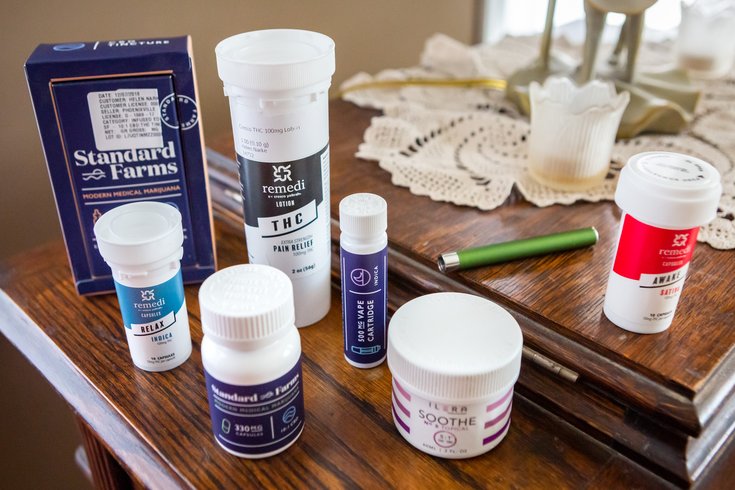
Thom Carroll/PhillyVoice
First of three parts
Various medical marijuana and CBD products that
Helen Narke has considered for treatment of her chronic pain.
As Dr. Lynn Bornfriend puts it, she was "absolutely no fun" in the 1970s and 1980s, when many of her peers were dabbling in recreational marijuana.
"I didn't touch marijuana," said Bornfriend, a psychiatrist at the Cancer Treatment Centers of America in Philadelphia. "I didn't want to talk to people who did."
Bornfriend held that attitude until her mother was diagnosed with cancer in 2014. At the time, she pushed back against her sister's inclinations to use medical marijuana as a remedy, disavowing it as a licensed medical professional.

- MONDAY: Medical marijuana and CBD are taking off: can it help you?
- TUESDAY: Amid shifting attitudes on medical marijuana, baby boomers become biggest buyers
- WEDNESDAY: Does CBD work? Science isn't sure, but Philly-area residents say it's helping them
"I burst into the apartment ready to intervene," Bornfriend said. "I found my mom sitting up. She was not in pain. She was not nauseous. She was not stoned. And she was eating."
Her mother did not survive her cancer battle, but Bornfriend said the medical marijuana improved her appetite and provided relief from her pain. It also reshaped Bornfriend's opinion about marijuana, resulting in a new outlook that embodies rapidly shifting attitudes in recent years.
As a result of that shift, the cannabis industry is booming.
Medical marijuana is now available in 33 states. Another 10 have legalized recreational marijuana. And cannabidiol – an active ingredient in cannabis better known as CBD – is seemingly on store shelves everywhere.
More than 2 million Americans are using medical cannabis products to improve their health or relieve pain. Untold others laud the perceived benefits of CBD, a non-psychoactive cannabis extract now being used in everything from topical creams to vape pens to ice cream.
These days, Bornfriend certifies patients for Pennsylvania's Medical Marijuana Program. She helps them determine the appropriate products and dosage, and when needed, eases their anxieties about using a drug that remains illegal in the eyes of the federal government.
"It's just very interesting to me that I have done a complete 180," Bornfriend said. "As a physician, I think it needs to be accessible and available to patients. The fears that people have – I don't want to be addicted. Let's talk about the opiates and benzos that you're on."
With the fear and stigma of cannabis lifting, more people are seeking out its therapeutic effects.
But understanding the differences between medical marijuana with THC and CBD products can be challenging, especially for people who have never used them.
MEDICAL MARIJUANA VS. CBD
To obtain medical marijuana, patients must enroll in state programs that require a physician to certify a qualifying medical condition. The programs – and the applicable medical conditions – vary by state.Both Pennsylvania and New Jersey permit medical marijuana to treat an abundance of conditions, including cancer, multiple sclerosis, epilepsy and chronic pain. Pennsylvania's list also includes autism, opioid use disorder and Parkinson's disease. In New Jersey, it can be used for anxiety, migraines and Tourette syndrome.
Medical marijuana must be purchased at a dispensary where patients are required to show state-issued identification cards. In addition to CBD, medical marijuana also contains tetrahydrocannabinol, or THC, the active chemical responsible for most of its psychoactive effects.
 Source/CTCA
Source/CTCA
Dr. Lynn Bornfriend is a psychiatrist at the Cancer Treatment Centers of America in Philadelphia.
"What's available at the medical marijuana dispensaries in Pennsylvania is CBD that comes from the medical marijuana plant," explained Dr. Ari Greis, director of the Medical Cannabis Department at Rothman Orthopaedic Institute in Philadelphia. "You cannot buy a pure CBD product from a dispensary in Pennsylvania. Everything has some THC in it."
By contrast, the CBD products sold online and in retail stores, including some pharmacies, are derived from hemp, a different cannabis plant that is no longer considered a Schedule I drug. Products are supposed to contain no more than trace amounts of THC.
But that is not always the case as the CBD industry remains largely unregulated. Three years ago, the U.S. Food and Drug Administration tested several CBD oils, finding that some contained little, if any CBD, while others contained illegal amounts of THC.
Beyond that, the FDA mostly has turned a blind eye to CBD, permitting the sale of products as long as they are not marketed as dietary supplements or claim to improve health outcomes.
"Not that the hemp-based CBD oils are all terrible, but there's not great regulation of what's going into it or what the percentage of it is," said Dr. Brooke Worster, who runs a medical marijuana clinic at Jefferson Health that has certified more than 400 patients since Pennsylvania's program launched last year.
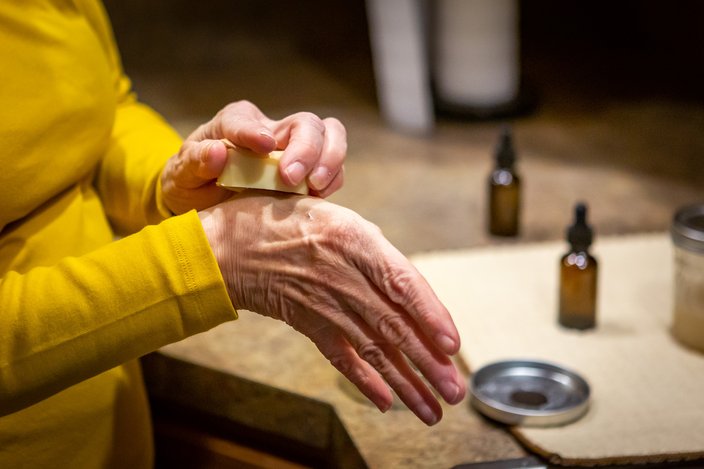 Thom Carroll/PhillyVoice
Thom Carroll/PhillyVoice
Judy
Beck applies a topical CBD salve to her hands. She uses several CBD
oils to help manage chronic pain caused by fibromyalgia, lupus and other
ailments.
DOES CBD WORK?
While medical marijuana research is rather limited – primarily because federal restrictions have prevented it – there is still more scientific inquiry on it than CBD. Despite some studies, the case for CBD products mostly rests on anecdotal evidence.That doesn't mean CBD does not have any benefits. Studies on animal models indicate it has therapeutic value, but there's a lot more to learn about cannabidiol.
"There's a greater number of patients that try hemp CBD and do not get any therapeutic benefit and then go on to try medical marijuana." – Dr. Ari Greis, Rothman Orthopaedic Institute"We're not studying a single molecule, which is often the case in the pharmaceutical industry," Greis said. "We're looking at a plant that has potentially over 100 ingredients that might be causing therapeutic effect. That's one of the real interesting – and also confusing – things."
Any one of those cannabinoids – or varying combinations of them – could prove most effective at treating one condition, Greis said. An entirely different combination might be best for another ailment.
But people don't need science to tell them that CBD tinctures and ointments are making them feel better. And the success stories are compelling.
Proponents claim CBD helps soothe anxiety, regulate mood and improve sleep – all without the psychoactive effects that can accompany medical marijuana. Others say it suppresses muscle spasms and alleviates body aches and other pain.
But the scientific evidence behind such claims is limited. The FDA has approved just one CBD-based drug, Epidiolex, based on clinical trials showing it reduced the frequency of seizures in two rare and severe types of epilepsy.
Some smaller clinical trials suggest CBD may alleviate anxiety and schizophrenia, said Sara Jane Ward, a preclinical researcher at Temple University's Lewis Katz School of Medicine who has studied CBD for the last 12 years. Even less is known about its impact on pain relief.
"Anything we know about CBD for pain comes from research where you're not just looking at pure CBD," Ward said. "You're looking at the combination of THC and CBD and various components of the plant. Everything else we know is all anecdotal from people."
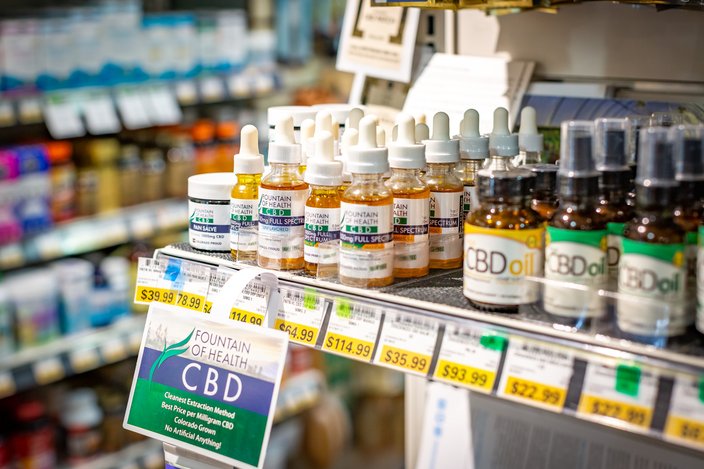 Thom Carroll/PhillyVoice
Thom Carroll/PhillyVoice
Fountain
of Health full-spectrum CBD oil products sit on the shelf at Across the
Way, the wellness and pet supply store by Weaver's Way Co-op in Mt.
Airy.
.
Selecting a CBD product – and determining the correct dosage – can take some trial and error.
Just like medical marijuana, CBD is sold in topical creams, tinctures, vape pens and edibles. But it's also being infused in all sorts of everyday food and beverages, including coffee, kombucha and ice cream.
Still, more clinical trials are needed to understand why CBD appears to do wonders for some people, but has little effect on others. Additional data is needed to determine the appropriate doses and any side effects. All of that will take years, experts say.
"We want to know all of this in various clinical populations," Ward said. "Hopefully, the funding opportunities – both the financing to do it and the legal issues – will be better, so that we can answer the question much better."
For now, much more is known about the effects of medical marijuana. That's why many doctors interviewed by PhillyVoice said they steer their patients in that direction.
"There's a greater number of patients that try hemp CBD and do not get any therapeutic benefit and then go on to try medical marijuana, where they get THC, plus CBD and a bigger variety of minor cannabinoids and terpines," Greis said. "From a pure pain relief standpoint, it seems like THC is one of the more important ingredients."
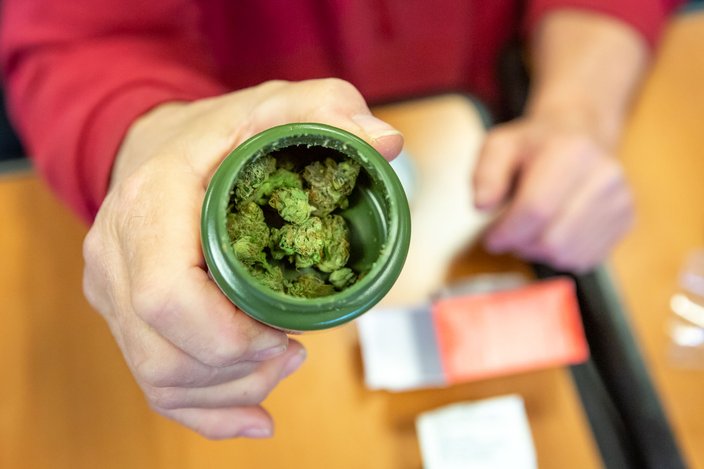 Thom Carroll/PhillyVoice
Thom Carroll/PhillyVoice
Mark
Dresnin, 71, of Philadelphia, shows a recent order of Grapefruit
Durban, a dry leaf sativa produced by Terrapin Care Station.
BENEFITS OF MEDICAL MARIJUANA
The most substantial evidence supporting medical cannabis as a therapeutic drug comes in regard to chronic pain. Studies have found that marijuana can provide modest pain relief for a range of underlying conditions, including neuropathy, cancer pain, rheumatoid arthritis and musculoskeletal issues."What we're seeing is a lot of people experiencing at least modest improvements in their pain," Greis said. "There's very few people that say it completely takes [their] pain away. But there seems to be a lot of people who say, 'I recognize I still have an arthritic back, but it lessens it so that I can function better.'"
At Rothman, Greis said patients most often complain of chronic lower back pain. But he also sees patients with pain in the neck, shoulders and knees, plus neuropathy.
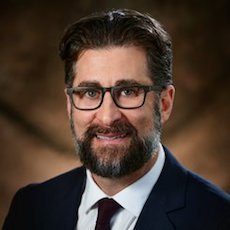 Source/Rothman Orthopaedics
Source/Rothman Orthopaedics
Dr. Ari Greis is the director of the Medical Cannabis Department at Rothman Orthopaedic Institute.
"What's been surprising to me is that I very rarely get phone calls from medical marijuana patients complaining of side effects," Greis said. "I get phone calls on a daily basis from patients who are starting off on new pharmaceuticals that are associated with dizziness."
There also is substantive evidence suggesting medical marijuana can relieve muscle spasms among multiple sclerosis patients. And it can reduce nausea and vomiting caused by chemotherapy treatments via the only two FDA-approved drugs containing THC.
At Cancer Treatment Centers of America, Bornfriend sees plenty of patients using myriad medications, including opioids, anxiety drugs and nausea medications. Oftentimes, it's the pain from chemotherapy that prompts patients to consider medical marijuana, she said.
"Chemo, you're going to have pain," Bornfriend said. "You're going to have nausea. You're going to have the GI irritable bowel stuff. It's a tremendous cause of peripheral neuropathy. Just going on and on and on – those are all symptoms marijuana helps."
"Traditional medicine is much more (that) the doctor will give you a prescription for X amount for X amount of time. This is more of finding what works with the individual's body chemistry." – Ryan Smith, COO of dispensary operator Cure Pennsylvania.Additionally, there is moderate evidence to suggest medical marijuana can improve sleep outcomes among people suffering from MS, fibromyalgia, chronic pain and sleep apnea syndrome.
More limited evidence suggests it improves anxiety symptoms, reduces post-traumatic stress disorder symptoms and increases appetite among cancer patients and people with HIV or AIDS.
To be sure, there are side effects associated with medical marijuana – and more could be determined with additional research.
The potential for intoxication can lead to injury and death. There is substantial evidence indicating marijuana heightens the risk of schizophrenia, worsens respiratory symptoms when smoked, and lowers the birth weight of infants among pregnant smokers.
"I really have started to see medical marijuana as another drug that has potential benefits and potential risks," Greis said. "By dosing it properly, it can oftentimes minimize side effects and allow people to function better with at least modestly improved symptoms."
There are additional drawbacks to medical marijuana. Because it remains federally illegal, it is not covered by insurance. An ounce of medical marijuana can cost hundreds of dollars.
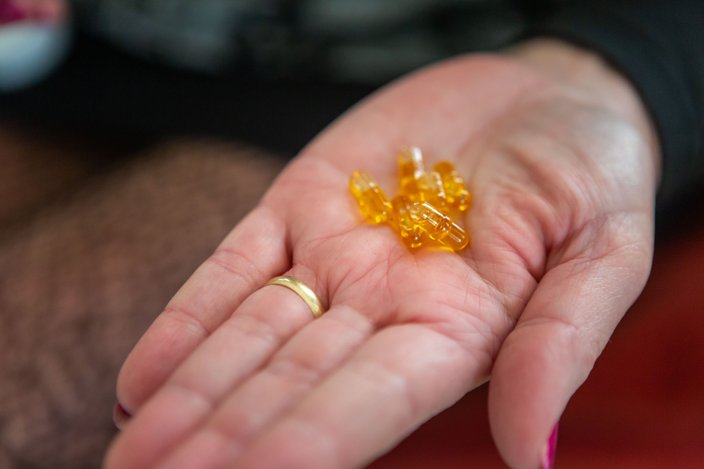 Thom Carroll/PhillyVoice
Thom Carroll/PhillyVoice
Helen
Narke of Schwenksville, Montgomery County, regularly uses more than a
half-dozen medical marijuana products to treat her pain. She has found
these capsules, with a 10-to-1 CBD to THC ratio, to be the most
effective.
HOW TO PICK A MEDICAL MARIJUANA PRODUCT
Technically, physicians do not prescribe medical marijuana to patients, because they are not approved by the FDA.Instead, doctors issue recommendations to certified patients. Unlike a prescription, where a patient only receives a specific amount of a specific medication, patients are free to purchase various forms of medical marijuana.
"Traditional medicine is much more (that) the doctor will give you a prescription for X amount for X amount of time," said Ryan Smith, chief operating officer of Cure Pennsylvania, which operates three dispensaries. "This is more of finding what works with the individual's body chemistry."
Some states limit the amounts that people can purchase. New Jersey restricts patients to two ounces per month. Pennsylvania's limit – a 30-day supply – is more nebulous.
Selecting a medical marijuana product – and finding the correct dose – can be confusing. Medical marijuana comes in various forms – tinctures, edibles, topical creams, vape pens and dry leaves. Further complicating the matter, they have different onset times and varying levels of THC and CBD.
"I try to give a lot of specific guidance and arm my patients, especially my elderly patients, with exactly what they should go in there looking for," Worster said.
Dosing often requires a bit of tweaking, partly because medical research remains relatively limited, Worster said. It could be 10 to 15 years before there is enough data to serve as a reputable guide, though she said her clinic has gradually become better over time at recommending doses for patients.
"We don't know enough to say everybody starts at 5 milligrams," Worster said. "It's very individualized."
For instance, some patients might use a product with low amounts of THC during the day to avoid any psychoactive effects and another with a higher THC level shortly before falling asleep.
The various forms present different options too, particularly in regard to onset and duration periods. Vaping medical marijuana generally offers immediate pain relief, but it may not last as long as the relief provided by a capsule that may take 90 minutes to fully kick in.
To some patients, the process of trying different products and tweaking doses is challenging.
Most doctors recommend beginning with small doses and, if necessary, gradually ramping upward – particularly when a patient is using a product with high amounts of THC. Some have different preferences on the forms they recommend. Worster, for example, said she never recommends leaf products partly because they can contain aspergillus – a fungus that sometimes causes significant fungal infections.
Bornfriend discourages patients from smoking it, which Pennsylvania – but not all states – forbids. She also shies away from edibles, because of their delay in taking effect.
"In most cases that seems more like a recreational thing to do than a medicine," Bornfriend said. "Usually, when you're using medicine, you're looking for a result pretty quickly."
And growing numbers of older Americans – including many in Philadelphia – have attained positive results in managing their pain from medical marijuana.

No comments:
Post a Comment